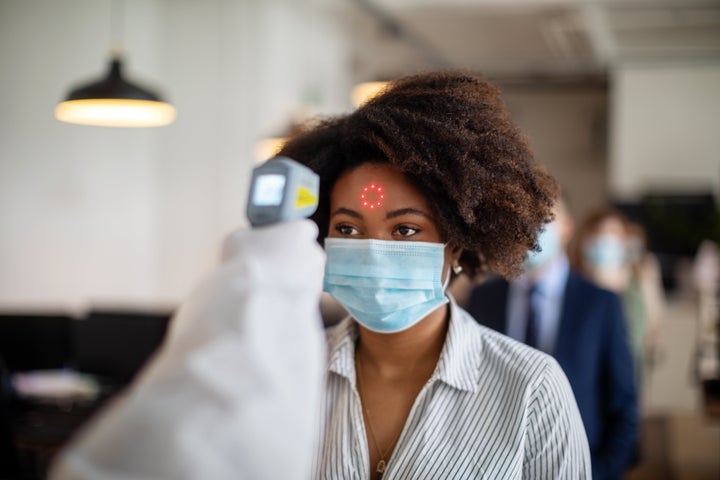If it hasn’t already, some sort of temperature check may be coming to your workplace.
Since fever is one of the symptoms of COVID-19, the Centers for Disease Control and Prevention recommends temperature checks as an optional strategy to screen out employees who may be arriving to work with the virus.
These thermal scans are part of the new normal of living and working through a pandemic. You may be scanned for fever at the door of your local restaurant, in the airport, entering Disney World, or before you can get your laptop checked at the Apple Store. In many offices, plants and factories, staff are required to have their temperature taken before being allowed to work.
But does this kind of temperature check actually work at limiting the spread of this infectious disease when employees spend all today together in the workplace? Not on its own. For one thing, a large number of patients don’t present with fever. Out of 5,700 people hospitalized with COVID-19 in the New York City area between March and April, only 30.7% showed fever symptoms, according to a study in the Journal of the American Medical Association.

People may also be asymptomatic but infectious at the moment they are getting a temperature check. As the World Health Organization notes for travelers in airports, “Temperature screening alone, at exit or entry, is not an effective way to stop international spread, since infected individuals may be in incubation period.”
“Just a pure fever check gives you a false sense of security. ‘I have a headache and I have muscle aches, but I don’t have a fever, so I can work.’”
- Kartik Cherabuddi, clinical associate professor of infectious diseases at the University of Florida
Temperature checks alone are not a reliable workplace prevention strategy.
Fever checks do have their use.
“Can it help a little bit in worksite screening? Yes,” said Kartik Cherabuddi, a clinical associate professor of infectious diseases at the University of Florida. “But it’s the third most important thing: symptom screening, PPE [personal protective equipment] or mask check, and then fever check.”
Cherabuddi said employers tend to focus on fever screening alone because it uses technology and the measurement feels objective. But used alone, it doesn’t catch the more common mild symptoms Cherabuddi sees in patients, such as fatigue, mild headaches, muscle aches and a scratchy throat.
“Just a pure fever check gives you a false sense of security: ‘I have a headache and I have muscle aches, but I don’t have a fever, so I can work,’” he said.
A more comprehensive symptom screening for employees would identify and take action on those milder symptoms, he said. Someone who discloses that they didn’t sleep well last night or that they have a mild headache, for example, could be told to get their PPE checked, social distance at work, monitor their symptoms for a few hours, and go home if those symptoms get worse.
But there’s a limit to what symptom screening can catch. For pre-symptomatic or asymptomatic employees, Cherabuddi said, having employees maintain their distance is key since it’s only way to prevent transmission when there’s no other way of telling if someone has the virus.
Fever screening is secondary prevention. Promoting healthy workplaces where employees aren’t pressured to work sick comes first.
Forcing people into long lines can give COVID-19 another way to spread. To prevent crowding at workplace checkpoints, Cherabuddi recommended scheduling employees to work in staggered shifts and marking the distances where people should be standing in line well apart from each other.
Fever checks are also relatively useless if employees haven’t bought into a more comprehensive plan to keep each other safe. More important than a fever check alone is making sure workers know why public health screening is necessary, Cherabuddi said. That could include using checkpoints as opportunities for eduction and to ensure people have appropriate PPE, he said.
Dr. Zeke McKinney, the primary occupational and environmental medicine provider at Minnesota’s HealthPartners RiverWay Clinic, calls fever screening a secondary prevention strategy. Primary prevention is having employees wearing masks and doing physical distancing, he said, and understanding that the actions they do outside of work matter for preventing COVID-19 spread at work, too.
Employers also need to do their part, opening a line of communication with staff that takes away pressure for people to work while sick. As the American College of Occupational and Environmental Medicine put it in its recommendations, “Paid sick leave is recommended to reduce the chances that a worker will come to work with COVID-19. Temperature screening of workers without paid leave may seem to be of greater value, but this is unproven.”
In other words, for a healthy workplace, employees should not hear mixed messages such as, “They tell us to stay home when we’re sick, but whenever I call in, my supervisor is really mad at me,” McKinney said.
Ultimately, the goal at worksite screening points is for positive symptoms to be treated with compassion and a plan of action, so that workers don’t feel penalized or shamed for disclosing them. Having open communication about everyone at work doing this symptom screening together “can raise a sense of ownership and collegiality that ‘we’re in this together,’” Cherabuddi said.
Experts are still learning about the novel coronavirus. The information in this story is what was known or available as of press time, but it’s possible guidance around COVID-19 could change as scientists discover more about the virus. Please check the Centers for Disease Control and Prevention for the most updated recommendations.